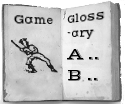Drive Ball: Difference between revisions
No edit summary |
No edit summary |
||
| Line 11: | Line 11: | ||
<p><span>[2] F. B. Sanborn, </span><em>New Hampshire Biography and Autobiography</em><span> (Private Printing, Concord NH, 1905), page 13.</span></p> | <p><span>[2] F. B. Sanborn, </span><em>New Hampshire Biography and Autobiography</em><span> (Private Printing, Concord NH, 1905), page 13.</span></p> | ||
|Comment=<p>[A] One might infer that this came was won when one player hit the ball past some agreed end-line.</p> | |Comment=<p>[A] One might infer that this came was won when one player hit the ball past some agreed end-line.</p> | ||
<p>[B] Block also spies another possible reference to drive ball in an 1862 engraving at, of all places, Camp Doubleday, named for General Abner Doubleday of Cooperstown NY.</p> | <p>[B] Block also spies another possible reference to drive ball in an 1862 engraving at, of all places, Camp Doubleday, a Civil War facility named for General Abner Doubleday of Cooperstown NY.</p> | ||
<p>"In the foreground of the illustration two soldiers face each other with bats, one striking a ball. Since no other players are involved, the only game that seems to correlate to the image is, in fact, drive ball. If not for Abner Doubleday's association, we would pay this little heed, but it is a matter of curiosity, if not amusement, to place baseball's legendary noninventor in such close proximity to a game involving a bat and ball." David Block, <span style="text-decoration: underline;">Baseball Before We Knew It</span> (UNebraska, 2005), page 198.</p> | <p>"In the foreground of the illustration two soldiers face each other with bats, one striking a ball. Since no other players are involved, the only game that seems to correlate to the image is, in fact, drive ball. If not for Abner Doubleday's association, we would pay this little heed, but it is a matter of curiosity, if not amusement, to place baseball's legendary noninventor in such close proximity to a game involving a bat and ball." David Block, <span style="text-decoration: underline;">Baseball Before We Knew It</span> (UNebraska, 2005), page 198.</p> | ||
<p> </p> | <p> </p> | ||
|Has Supplemental Text=No | |Has Supplemental Text=No | ||
}} | }} | ||
Revision as of 06:09, 8 March 2016
| Game | Drive Ball |
|---|---|
| Game Family | Fungo |
| Location | New England |
| Regions | US |
| Eras | Predecessor, 1800s |
| Invented | No |
| Tags | |
| Description | [1] Drive ball: An 1835 book published in New Haven describes drive ball. David Block's summary: "In this activity, two boys with bats face each other, taking turns fungoing the ball. When one boy hits the ball, the other has to retrieve it as quickly as he can, then fungo it back from the spot he picked it up." [2] Drive: A ball game, listed along with the Old Cat games and Baseball, mentioned in the memoirs of a New Hampshire man born in 1831. The rules of this game are not given. It may not have been a baserunning game. |
| Sources | [1] The Boy's Book of Sports; a Description of the Exercises and Pastimes of Youth (New Haven, S. Babcock), 24 pages. Summarized in David Block, Baseball Before We Knew It (University of Nebraska Press, 2005), page 198. An 1849 chapbook from Babcock also mentions drive ball as the last mentioned of six common games played with a ball, naming "base-ball, trap ball, cricket, up-ball, catch-ball and drive ball." See Juvenile Pastimes; or Girls' and Boys' Book of Sports (New Haven, S. Babcock), 16 pages, per David Block, Baseball Before We Knew It, page 212. [2] F. B. Sanborn, New Hampshire Biography and Autobiography (Private Printing, Concord NH, 1905), page 13. |
| Source Image | [[Image:|left|thumb]] |
| Comment | [A] One might infer that this came was won when one player hit the ball past some agreed end-line. [B] Block also spies another possible reference to drive ball in an 1862 engraving at, of all places, Camp Doubleday, a Civil War facility named for General Abner Doubleday of Cooperstown NY. "In the foreground of the illustration two soldiers face each other with bats, one striking a ball. Since no other players are involved, the only game that seems to correlate to the image is, in fact, drive ball. If not for Abner Doubleday's association, we would pay this little heed, but it is a matter of curiosity, if not amusement, to place baseball's legendary noninventor in such close proximity to a game involving a bat and ball." David Block, Baseball Before We Knew It (UNebraska, 2005), page 198. Edit with form to add a comment |
| Query | Edit with form to add a query |
| Has Supplemental Text |
Comments
<comments voting="Plus" />
